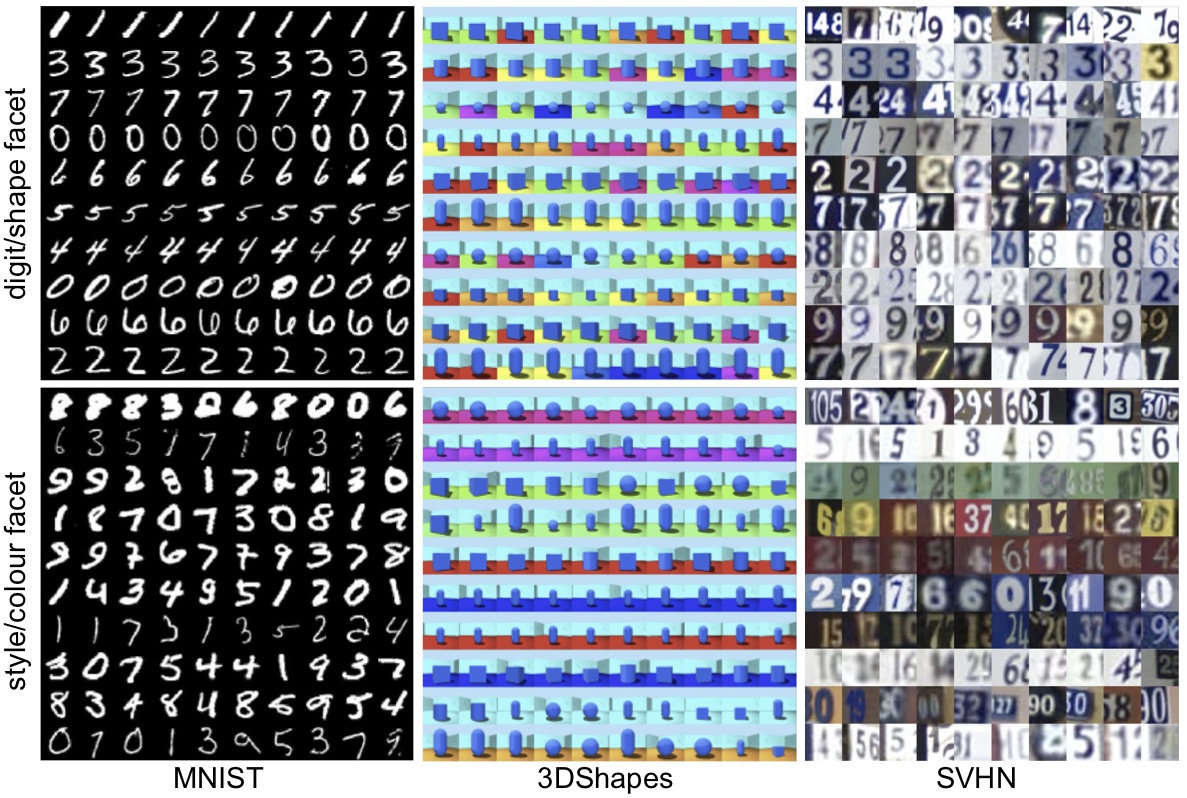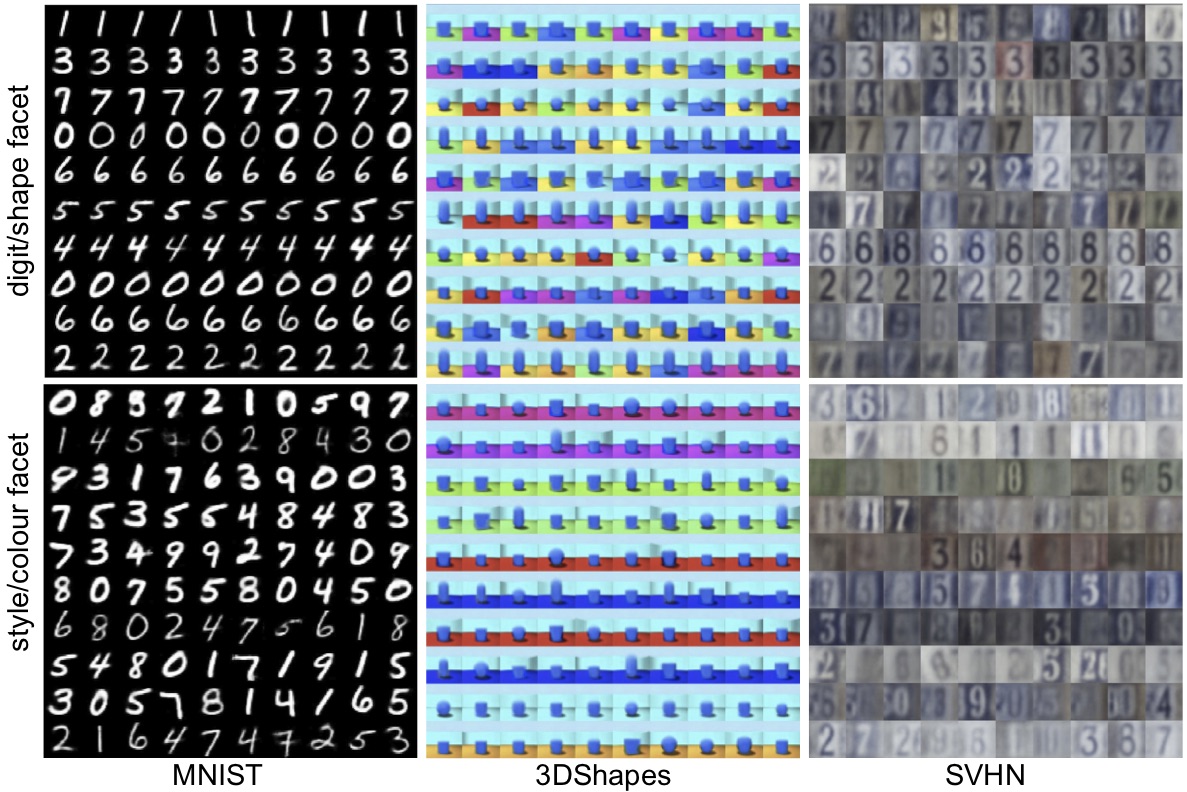Installation | Contents | Reproducing main results | Training | Evaluation | Pre-trained Models | Results | Contributing | Citation
This repository is the official implementation of Multi-Facet Clustering Variational Autoencoders (MFCVAE).
MFCVAE is a principled, probabilistic clustering model which finds multiple partitions of data simultaneously through its multiple Mixtures-of-Gaussians (MoG) prior. Our model lies in the framework of variational autoencoders, and is trained fully unsupervised.
MFCVAE discovers a disentangled multi-facet structure in an exploratory setting, allows to compose representations of inputs in the latent space, perform generative classification, and generate diverse, synthetic samples.
The MFCVAE model is implemented with the PyTorch Distributions package, the training script and other network related operations are using PyTorch.
Click here for training runs reproducing our main results (Weights&Biases).
Let us first set up a new, empty anaconda environment mfcvae as
conda create -n mfcvae
Next, we activate mfcvae:
conda activate mfcvae
Note that throughout this README, we will assume that the environment mfcvae is activated.
We install pip as
conda install pip
Then, we install all dependencies of our code from the requirements.txt as
pip install -r requirements.txt
(Optional): As an alternative way to install your conda environment,
we also provide our environment.yml.
We note that this sometimes causes
dependency problems, especially when used in operating systems other than Linux.
You can use it to create your conda environment in a single step as
conda env create -f environment.yml
and activate it afterwards as
conda activate mfcvae
This implementation allows training and evaluating MFCVAE on three datasets: MNIST, 3DShapes, and SVHN.
MNIST and SVHN will be automatically downloaded into the folder data/ when running train.py for the first time.
For 3DShapes, you must download the file 3dshapes.h5 from this link
(see the 3DShapes repository for further instructions)
and put this file into a directory data/Fast_3DShapes/raw/.
To visualise and log our experimental results, we use wandb as a dependency.
wandb is a logger (just like Tensorboard) which stores all information of a run (hyperparameter configs, experimental results, gradients, losses, ...) on a server that can be accessed via a website.
To use wandb, one needs to set up an account here.
Further, one has to create a team with a team_name (for academics, creating a team is free, see this link)
and within that team a project with a project_name.
Your account also comes with a login_key (or API key), which you can find under your account (top-right) when logged in ->
settings -> API key. The login key is a hash of >10 characters.
You can collaborate with others by working on the same wandb project, but using
different login keys.
You can use 'user1' or 'user2' as values for the command line argument --user
in train.py to choose the stored login_key_1 or login_key_2 in configs/wandb.yml, respectively (see below).
To use your wandb details within this project, change configs/wandb.yml as follows:
First, define the login/API key:
login_key_1: <your-api-key> # referring to API key of 'user1', for example 'c83202x.........'and (optionally)
login_key_2: <your-api-key> # referring to API key of 'user2'Then define the team name and project name:
team_name: <your-team-name> # e.g. 'clustering'
project_name: <your-project-name> # e.g. 'mfcvae'After setting these, you will now be able to do the following:
- Perform single runs by executing
train.py, - Start or attach sweeps by running
start_sweep.pyorattach_sweep.py, with results logged onwandb.
The following table gives an overview on the main contents (files and directories) of this repository:
| File or Directory | Description |
|---|---|
configs/ |
Contains several .yaml files, one per dataset (configuration), specifying the hyperparameters of each reported run. |
data/ |
Directory where data is downloaded to and stored. |
graphics/ |
Directory for figures in this README. |
new_trained_models/ |
Directory for storing any newly trained models. |
pretrained_models/ |
Directory for storing pretrained models. |
results/ |
Directory for storing results. |
shell_scripts/ |
Directory where all shell scripts for reproducing our main results in the paper are stored. |
wandb/ |
wandb directory where individual runs are stored. |
start_sweep.py, attach_sweep.py |
Scripts for starting a sweep (e.g. over random seeds) and attaching further machines to a sweep. |
mfcvae.py, conv_vlae.py, models_fc.py |
Files implementing MFCVAE, as well as several sub-modules of its architecture. |
datasets.py |
Implementing dataset classes. Note that all datasets are implemented so that they are stored right on GPU during training to reduce training time. We provide a customised Dataset class for 3DShapes, and for the most part resemble the torchvision Dataset class for MNIST and SVHN. |
environment.yml |
yaml file for setting up the Anaconda evnironment. |
eval_compositionality.py, eval_sample_generation.py, eval_top10_cluster_examples.py |
Scripts to produce the plots in the experiments section of our paper. |
load_model.py |
Script to load the MFCVAE model from a .pt and args serialized files. |
plot_intuition.py |
Implementation of Figure 1 in our paper. |
plotting.py |
Functions to create various plots. |
train.py |
Training script for MFCVAE (main script used for training a model). |
utils.py |
Miscellaneous functions. |
We use wandb for logging the following results and information (note that many of these are logged for train and test data):
- Gradients of loss function w.r.t. all parameters of the model (figure)
- All components of the 5-term loss function and overall loss (scalar)
- Sample generation plots, one per facet (figure)
- Input examples assigned to clusters, one per facet (figure)
- Input examples and corresponding reconstructions, one per facet (figure)
- Confusion matrix, one per label (figure)
- pi parameters of p(c_j), bar chart, one per facet (figure)
- Number of input examples assigned per cluster, rug plot, one per facet (figure)
- Unsupervised clustering accuracy, 1) plain, one per facet 2) weighted (by class frequency), one per facet 3) mean and 4) maximum over labels and facets (scalar)
- Number of clusters with at least one input example assigned, one per facet (scalar)
The main results in this paper, including the most important figures,
were logged using wandb. We make our final runs, which have the exact same
configurations as reported in our main paper, public, and they can be viewed
under the following link: https://wandb.ai/clustering/mfcvae.
In the following, we show how to reproduce these 'main results', and provide 3 ways with increasing computational requirements:
- Reproducing our plots with provided pretrained models,
- rerunning a single run on each dataset,
- and running 10 runs per dataset with different random seeds.
In pretrained_models/,
we provide trained models of a specific run with the hyperparameters detailed
in our paper and provided as .yaml files in the repository configs/.
To retrieve all plots in our main paper, run the corresponding evaluation shell
script eval_<dataset>.sh in shell_scripts with these
pretrained models for the dataset of your choice:
./eval_<dataset>.sh # e.g. ./eval_mnist.sh
Note that this assumes you have execute permissions on this file (do e.g. chmod 777 eval_mnist.sh
first if you need to set these permissions).
The pretrained models used here can itself be produced using the second way described next.
To train a model with a certain random seed from scratch using the hyperparameter configurations
detailed in our paper and provided as .yaml files in the repository configs/, we provide
another 4 shell scripts. These are named run_<dataset>.sh, and can be run as:
./run_<dataset>.sh # e.g. ./run_mnist.sh
Note that this will start a run, and on the command line output, a link to the run on the
wandb server will be shown. Copy this link and paste it into your browser to see
further logs of this run (as detailed above). Note that these are different to the plots and
logs produced by the eval_<dataset>.sh scripts.
Once training has completed, your model will be saved as a file save_dict.pt in the wandb directory in the folder wandb/ of that run.
Alternatively, you can download it from the run page -> Files (left-hand side) -> download save_dict.pt.
Then, to get all result figures (input examples, generations, compositionality), store the model in the folder
new_trained_models/ and adapt the eval_<dataset>.sh to use the correct path (or use the eval_<dataset>.py scripts directly).
As we argue in the paper, stability is crucial in deep clustering, and one way to test it
is by doing a "sweep", i.e. 10 runs, with different random seeds for initialisation.
To do so, use the scripts sweep_seed_<dataset>.sh as follows:
./sweep_seed_<dataset>.sh # e.g. ./sweep_seed_mnist.sh
On your command line output, in addition to the run link, you will see a sweep link that you can
open to check the sweep's runs and their logs. If you have multiple machines at hand, you can "attach"
them to this sweep. This means that they will grab the next seed value, and train a model from scratch,
until all 10 models are trained. To do so, use the attach_sweep.py script with the --config_args_path
argument corresponding to your dataset. For example, if you started the sweep for MNIST and it has
sweep ID chvie4r1 (which you can find on the info page on wandb), execute:
python3 attach_sweep.py --sweep_id chvie4r1 --config_args_path "configs/mnist.yaml"
As before, you can subsequently pick one or all of the runs in this sweep, get the model, and post-process the evaluation plots.
To train a model, use the train.py script. First, go to the repository folder:
cd <path-to-repository>/mfcvae/
Then, call the train script as
python train.py --<arg1> <value1> ...
One can change a long list of configurations,
e.g. what dataset to train on, which device to use, which value of J to pick, ... .
We refer to the train.py script and the help descriptions for details on how to
use these arguments in detail.
In particular, we would like to point out that our implementation of MFCVAE
can be used as a single-facet clustering model by setting --J_n_mixtures in
train.py to 1.
Also, we refer to the scripts start_sweep.py and attach_sweep.py as used above
to run hyperparameter sweeps.
To evaluate a trained model, we refer to two ways (see also notes on reproducing results above):
- Use the
wandbinterface on the corresponding run link, where we log a long list of metrics and plots, including loss (components), accuracies, confusion matrices, reconstruction plots, number of clusters during training in each facet, etc.. - To produce the plots in our paper, one can use the python scripts
eval_<plot_type>.pyor the correspondingeval_<dataset>.shshell scripts.
In pretrained_models/,
we provide trained models of a specific run with the hyperparameters detailed
in our paper and provided as .yaml files in the repository configs/.
To evaluate the pretrained models, we refer to the section Reproduce results using pretrained models above.
We briefly illustrate key results from our experiments. For details we refer to our paper.
| MNIST | 3DShapes (configuration 1) |
3DShapes (configuration 2) |
SVHN | |
|---|---|---|---|---|
| MFCVAE (J=2) | 92.02% ± 3.02% | floor colour: 99.46% ± 1.10% object shape: 88.47% ± 1.82% |
wall colour: 100.00% ± 0.00% object shape: 90.05% ± 2.65% |
56.25% ± 0.88% |
We welcome extensions of this repository, for example to new datasets and tasks! Please leave us an us issue if you have any questions, find bugs or would like to work with us!
If this code is useful to your work, please cite our paper as follows:
@misc{falck2021multifacet,
title={Multi-Facet Clustering Variational Autoencoders},
author={Fabian Falck and Haoting Zhang and Matthew Willetts and George Nicholson and Christopher Yau and Christopher C Holmes},
year={2021},
eprint={2106.05241},
archivePrefix={arXiv},
primaryClass={stat.ML}
}








